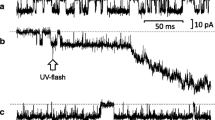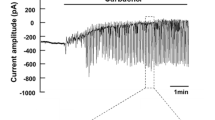Summary
The ability of the main excretory duct of the rat submaxillary gland to transform a plasmalike, primary saliva into a low sodium, high potassium, final salvia, was investigated using a technique of continuous microperfusion.
1. When the duct was perfused with Ringers solution, there was a nett efflux of sodium, and a smaller nett influx of potassium, until steady-state electrolyte concentrations of 2.8 mEq/l for sodium and 135 mEq/l for potassium developed in the luminal fluid. These changes were accompanied by a small nett water efflux which declined as the steady-state concentrations were approached. The flux rates of water and electrolytes observed were sufficient to account for the changes in salivary composition observed under free-flow conditions as precursor saliva passed along the main duct to the mouth.
2. Perfusion of the duct with sodium-free solutions resulted in a nett influx of sodium to establish the same steady-state sodium concentration. Nett potassium influx also took place, although the rate of influx was reduced by more than 50% when compared with that observed during perfusion of the duct with Ringers solution.
3. Measurement of trans-epithelial potential differences associated with various intraluminal sodium and potassium concentrations demonstrated an approximately logarithmic relationship between potential difference and the intraluminal sodium concentration. The trans-epithelial potential difference was about −70 mV (lumen negative) when the duct was filled with Ringers solution, and about −11 mV (lumen negative) under steady-state (high potassium, low sodium) conditions.
4. Calculations of the electrochemical potential gradients for sodium and potassium under steady-state conditions demonstrated that both these cations underwent active transport. In addition, potassium secretion was enhanced by a favourable electrical gradient associated in some way with active sodium transport.
Similar content being viewed by others
References
Davis, H.: Excitation of auditory receptors. In: Handbook of Physiology. Sect. 1, Vol. 1, Chapt. 23, pp 574–575. Washington, D. C.: American Physiological Society 1959.
Diamond, J. M.: The reabsorptive function of the gall bladder. J. Physiol. (Lond.) 161, 442–473 (1962).
— The mechanism of isotonic water transport. J. gen. Physiol. 48, 15–42 (1964).
Dodd, W. A., M. G. Pitman, and K. R. West: Sodium and potassium transport in the marine alga Chaetomorpha darwinii. Aust. J. biol. Sci. 19, 341–354 (1966).
Holzgreve, H., J. R. Martinez, and A. Vogel: A micropuncture and histologic study of submaxillary glands of young rats. Pflügers Arch. ges. Physiol. 290, 134–143 (1966).
Kashgarian, M., H. Stöckle, C. W. Gottschalk, and K. J. Ullrich: Transtubular electrochemical potentials of sodium and chloride in proximal and distal renal tubules of rats during antidiuresis and water diuresis (Diabetes insipidus). Pflügers Arch. ges. Physiol. 277, 89–106 (1963).
Kernan, R. P.: Cell K. Washington, D.C.: Butterworths 1965.
Leaf, A.: Transepithelial transport and its hormonal control in toad bladder. Ergebn. Physiol. 56, 216–263 (1965).
— J. Andersen, and L. B. Page: Active sodium transport by the isolated toad bladder. J. gen. Physiol. 41, 657–668 (1958).
Malnic, G., R. M. Klose, and G. Giebisch: Micropuncture study of renal potassium excretion in the rat. Amer. J. Physiol. 206, 674–686 (1964).
— Micropuncture study of distal tubular potassium and sodium transport in rat nephron. Amer. J. Physiol. 211, 529–547 (1966).
— Microperfusion study of distal tubular potassium and sodium transfer in rat kidney. Amer. J. Physiol. 211, 548–559 (1966).
Martinez, J. R., H. Holzgreve, and A. Frick: Micropuncture study of submaxillary glands of adult rats. Pflügers Arch. ges. Physiol. 290, 184–192 (1966).
Phillips, S. F., and C. F. Code: Sorption of potassium in the small and large intestine. Amer. J. Physiol. 211, 607–613 (1966).
Pitman, M. G., and H. D. W. Saddler: Active sodium and potassium transport in cells of barley roots. Proc. nat. Acad. Sci. (Wash.) 57, 44–49 (1967).
Ramsay, J. A., and R. H. J. Brown: Simplified apparatus and procedure for freezing point determination upon small volumes of fluid. J. sci. Instrum. 32, 372–375 (1955).
Schögel, E., and J. A. Young: Micropuncture and perfusion investigation of sodium and potassium transport in the rat submaxillary gland. J. Physiol. (Lond.) 183, 73–75 P (1966).
Thaysen, J. H.: Handling of alkali metals by exocrine glands other than the kidney. In: The alkali metal ions in biology. Handbuch der experimentellen Pharmakologie. Ergänzungswerk Bd. 13, S. 424–507. Berlin, Göttingen, Heidelberg: Springer 1960.
Ussing, H. H.: The alkali metal ions in isolated systems and tissues. In: Handbuch der experimentellen Pharmakologie. Ergänzungswerk Bd. 13, S. 1–195. Berlin, Göttingen, Heidelberg: Springer 1960.
--, and B. Andersen: The relation between solvent drag and active transport of ions. Proc. 3rd int. congr. Biochem. pp. 434–440. Brussels 1955.
Wilson, T. H.: Intestinal Absorption, pp. 139–140. Philadelphia, London W. B. Saunders & Co. 1962.
Young, J. A., and K. D. G. Edwards: Clearance and stop-flow studies on histidine and methyldopa transport by rat kidney. Amer. J. Physiol. 210, 667–675 (1966).
-- E. Frömter, and E. Schögel: Electrolyte fluxes and potential differences in the main excretory duct of the rat submaxillary gland. Pflügers Arch. ges. Physiol. 289, 81 R (1966).
—, and E. Schögel: Micropuncture investigation of sodium and potassium excretion in rat submaxillary saliva. Pflügers Arch. ges. Physiol. 291, 85–98 (1966).
Author information
Authors and Affiliations
Additional information
C. J. Marin Travelling Research Fellow of the National Health and Medical Research Council of Australia. Present Address: Department of Physiology, University of Sydney, N.S.W. Australia.
Rights and permissions
About this article
Cite this article
Young, J.A., Frömter, E., Schögel, E. et al. A microperfusion investigation of sodium resorption and potassium secretion by the main excretory duct of the rat submaxillary gland. Pflügers Archiv 295, 157–172 (1967). https://doi.org/10.1007/BF00362747
Received:
Issue Date:
DOI: https://doi.org/10.1007/BF00362747




